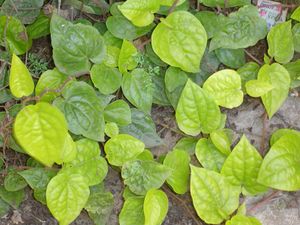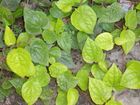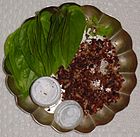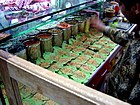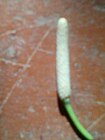Note: This is a project under development. The articles on this wiki are just being initiated and broadly incomplete. You can Help creating new pages.
Piper betle - Nagavallari
Piper betle is eulogized by ayurveda acharyas for their immense medicinal properties. Piper betle is a vine which belongs to Piperacea family. This vine has heart shaped leaves and is mostly grown in South East Asia.
Contents
[hide]- 1 Uses
- 2 Parts Used
- 3 Chemical Composition
- 4 Common names
- 5 Properties
- 6 Habit
- 7 Identification
- 8 List of Ayurvedic medicine in which the herb is used
- 9 Where to get the saplings
- 10 Mode of Propagation
- 11 How to plant/cultivate
- 12 Commonly seen growing in areas
- 13 Photo Gallery
- 14 References
- 15 External Links
Uses
Wounds, Joint pains, Stomach colicky, Indigestion, Bad breath, Weight loss, Erectile disfunction, Diarrhea, Sore throats.
Parts Used
Chemical Composition
Leaf contains Water (85-90%), Proteins (3-3.5%), Carbohydrates (0.5-6.1%), Minerals (2.3-3.3%), Fat (0.4-1%), Fibre (2.3%), Essential oil (0.08-0.2%), Tannin (0.1-1.3%), Alkaloid. [1]
Common names
| Language | Common name |
|---|---|
| Kannada | Veelyade Ele |
| Hindi | |
| Malayalam | |
| Tamil | Vettilai |
| Telugu | Tamalapaku |
| Marathi | NA |
| Gujarathi | NA |
| Punjabi | NA |
| Kashmiri | NA |
| Sanskrit | |
| English | Betel pepper |
Properties
Reference: Dravya - Substance, Rasa - Taste, Guna - Qualities, Veerya - Potency, Vipaka - Post-digesion effect, Karma - Pharmacological activity, Prabhava - Therepeutics.
Dravya
Rasa
Tikta (Bitter), Kashaya (Astringent)
Guna
Laghu (Light), Ruksha (Dry), Tikshna (Sharp)
Veerya
Ushna (Hot)
Vipaka
Katu (Pungent)
Karma
Kapha, Vata
Prabhava
Habit
Identification
Leaf
| Kind | Shape | Feature |
|---|---|---|
| Simple | Ovate-oblong | Those at apex of stem sometimes elliptic, 7-15 × 5-11 cm |
Flower
| Type | Size | Color and composition | Stamen | More information |
|---|---|---|---|---|
| Unisexual | 2-4cm long | Yellow | 2 | Flowers Season is May-Jul |
Fruit
| Type | Size | Mass | Appearance | Seeds | More information |
|---|---|---|---|---|---|
| General | 7–10 mm | Clearly grooved lengthwise, Lowest hooked hairs aligned towards crown | Many | {{{6}}} |
Other features
List of Ayurvedic medicine in which the herb is used
Where to get the saplings
Mode of Propagation
How to plant/cultivate
Cuttings 30 - 45cm long, taken from the tips of vertical shoots.[4]
Commonly seen growing in areas
Trophical area, Coastal areas.
Photo Gallery
References
External Links
- Ayurvedic Herbs known to be helpful to treat Wounds
- Ayurvedic Herbs known to be helpful to treat Joint pains
- Ayurvedic Herbs known to be helpful to treat Stomach colicky
- Ayurvedic Herbs known to be helpful to treat Indigestion
- Ayurvedic Herbs known to be helpful to treat Bad breath
- Ayurvedic Herbs known to be helpful to treat Weight loss
- Ayurvedic Herbs known to be helpful to treat Erectile disfunction
- Ayurvedic Herbs known to be helpful to treat Diarrhea
- Ayurvedic Herbs known to be helpful to treat Sore throats
- Herbs with Vines used in medicine
- Herbs with Leaves used in medicine
- Herbs with Roots used in medicine
- Herbs with Fruits used in medicine
- Herbs with common name in Kannada
- Herbs with common name in Tamil
- Herbs with common name in Telugu
- Herbs with common name in English
- Habit - Evergreen climbing shrub
- Index of Plants which can be propagated by Cuttings
- Herbs that are commonly seen in the region of Trophical area
- Herbs that are commonly seen in the region of Coastal areas
- Herbs
- Piperaceae
